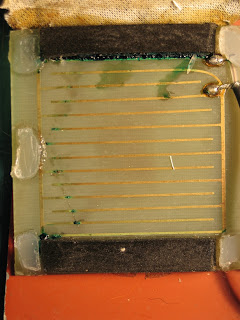Sunday, August 30, 2015
Sunday, December 28, 2014
Curiouser and curiouser







The new PoS is still a little overly sensitive, but a few more tweaks and it ought to be dialed in perfectly. In fact, now that I know about the graphite effect, I am going to reopen my #45, and make that pad a little more sensitive as well. I may also add some padding to it, too, for easier articulation.
Wednesday, December 17, 2014
Fergus Marsh
Yesterday my multi-year saved search in eBay alerted me to the presence of an ACTUAL Patch of Shades. It had a buy-it-now of $300, so I bought it now. I guessed that the owner had no idea what previous Patch of Shades had sold for on eBay. I bought mine for $520. The next one, purchased by audities.org, a museum of electronic music rarities, fetched $1200.
What I didn't know was that the seller was none other than Fergus Marsh, brother of Hugh Marsh, and Bruce Cockburn's stick player in the 1980s! I flipped when I saw who I had Paypalled money to on my bank statement this morning. I emailed him, and he sent a very sweet reply, even telling me which "Brucie" songs he had used the effect pedal on.
I wrote: "Holy Wow!!!!! You're Fergus Marsh?!?!?!? As in, played stick with Bruce Cockburn? I am not a big follower of stick, but you are my absolute FAVORITE stick player. Thanks so much for all the gorgeous sounds over the years!! David"
Fergus replied: "Hey David, thanks for the kind words. Just to let you know, i used the patch of shades on a couple of Brucie tunes. Down where the death squad lives was one of them. I used a flanger in the loop that engages with the wah effect. It was pleasingly nasty. ( on the bass end of the stick) Hope you enjoy it. Ferg"
Wow!
Sunday, April 14, 2013
The Foot Pedal Repair
The first photo shows the foot pad pulled off the orange housing bay, and the top part of the pad slipped out of the enclosure and placed to the left side of the enclosure. In the black enclosure is the circuit board revealed in photo 2 below.
On the the right side of photo 2, you are looking at a firm ivory colored piece of plastic with a black rectangle rubber with a conductive set of bars printed on to it. This conductive pattern is placed at a 90° angle to the gold patterned circuit board revealed on the left. The circuit board consists of two disconnected circuit patterns connected to two wires that lead back into the main Patch of Shades enclosure. When the conductive black rubber is pressed against the circuit board lines, the circuit closes, the resistance is lowered as more pressure is added.
Photo 3 shows why my Patch of Shades was not working. A line of corrosion had made its way across the circuit lines, interfering with the pressure pad.
Some of the corrosion might have made its way onto the conductive pad as well.
Water, toe sweat, circuit board cleaning fluid, manufacturing by-product? We will never know...
Scrubbed both boards all clean with an acetone based circuit board cleaning fluid (probably not so good for the atmosphere, but cleans better than alcohol).
The key to easily putting it all back together...hot glue gun!!!! A hot glue gun will make it easy to re-wrap each piece of faux leather tightly enough, and also makes it easy to firmly remount the pad into the orange foot pedal area. Also, hot glue, while being a good tight hold, can also be peeled off and done over easily. I took advantage of this feature of hot glue several times during this repair, as I initially did not place the conductive pad in the correct orientation with the circuit board. If you are attempting this repair, careful observation of orientation during take apart will save you trouble later on.
In my next posting (whenever that occurs), I will upload some MP3s of the sounds that the various settings on the Patch of Shades avails me.












